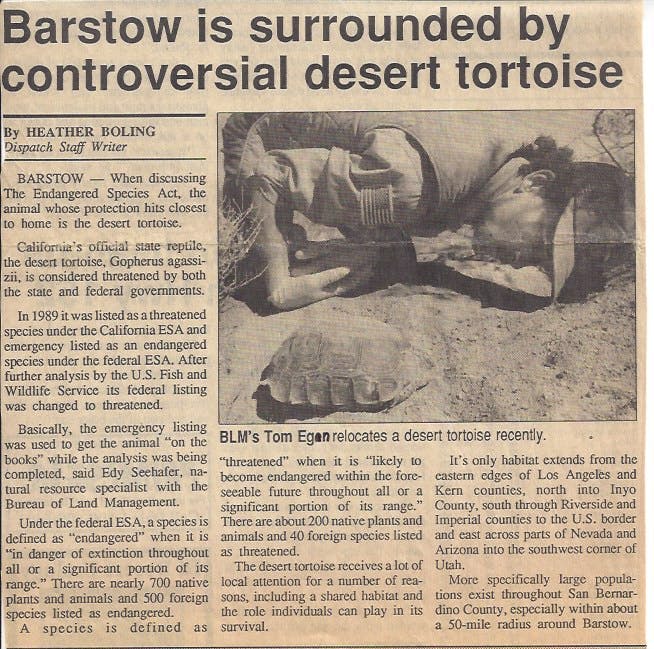Twenty-five years ago, on October 31, 1994, President Bill Clinton signed the California Desert Protection Act (CDPA, or Public Law 103-433) into law, affecting almost 9.2 million acres of public land supporting our nation’s wildlife, stretching southward from the far northern end of Death Valley to the United States-Mexico border. Standing beside him at the signing were numerous desert advocates who had spent more than a decade working to protect California’s unique desert ecosystem through the passage of this Act. Elden Hughes, a long-time desert conservationist, held a box with five baby tortoises to witness this special event, as this bill provided millions of acres of additional protections for California’s state reptile, Agassiz’s desert tortoise, desert bighorn sheep, and golden eagle, and many other plant and animal species.


In her first term as California Senator, Dianne Feinstein took over authorship of the CDPA from Senator Alan Cranston, who had worked tirelessly to protect the California’s desert prior to leaving public service. California’s Senator Barbara Boxer and California's House delegation also came together to support this effort, after years of political maneuvering to thwart this gargantuan effort.
The CDPA is one of the most extensive and significant pieces of environmental legislation enacted by the United States Congress, protecting three geologically and ecologically unique desert ecosystems (Mojave, Colorado & Great Basin Deserts) and representing one of the largest intact landscapes remaining in the lower 48 states. This area is home to millions of acres of rare plants, including the iconic Joshua tree; migratory & nesting birds, reptiles, amphibians, fish, insects; and charismatic herbivores such as the desert tortoise, desert bighorn, and Mohave ground squirrel, which is not found anywhere else on Earth.



Included within the CDPA designations were the creation of the 1.4-million-acre Mojave National Preserve out of the East Mojave National Scenic Area, Death Valley and Joshua Tree National Parks out of existing national monuments; transferal of 20,500 acres of public land administered by the United States Bureau of Land Management (BLM) to the State of California to expand Red Rock Canyon State Park; designation of 74 new wilderness areas in the California desert, totaling 7,661,069 acres to be managed by the National Park Service (NPS), BLM, and United States Forest Service; and designation of eight wilderness study areas (WSAs). These designations totaled 326,430 acres to be managed in perpetuity by BLM; including several areas with nationally spectacular features such as the 9,000-acre Granite Mountain Natural Preserve, the 2,040-acre Desert Lily Sanctuary, and the 590-acre Dinosaur Trackway Area of Critical Environmental Concern (ACEC).
Lands protected through the CDPA not only benefit the wildlife who depend upon them for their very survival, they also serve to protect our groundwater and open space, in addition to drawing millions of visitors from all over the world each year, bolstering desert communities, driving local economies and creating jobs. These protected lands, our children’s legacy, are the backbone of a thriving ecotourism economy, while also providing public land rights-of-ways for our utilities and linear transmission lines, as well as security buffers for several military installations within the California desert.
Following the signing of the CDPA into law Defenders’ two California desert biologists, Jeff Aardahl and Tom Egan, remember this historic event vividly as they were both, at the time, working for the federal government to protect and conserve this desert and its iconic wildlife. Jeff and Tom have since worked tirelessly to fulfill the conservation vision that drove the creation of this Act.
At the time of the Act’s passage, Jeff was the NPS Resources Branch Chief at Death Valley National Monument, which subsequently became a national park. He worked with Senator Feinstein’s staff on the boundary of the proposed national park, making sure that as much as the Amargosa River drainage possible south of Death Valley Junction on the California-Nevada border, as well as public lands in the Panamint Range to the west of the Monument, were included in the newly designated park. Jeff recalls a lively celebration by NPS staff at the Death Valley facilities following passage of the CDPA, with Park Superintendent Ed Rothfuss highlighting the significance of the event in establishing Death Valley as the largest national park in the lower-48 States. Superintendent Rothfuss was so inspired that he handed out new hats he had personally purchased embroidered with the words “Death Valley National Park.”


Tom Egan was the Lead Wildlife Biologist for the BLM’s Barstow Field Office when the Act became law. Tom had spent the four preceding years (1990-1994) working to implement existing Areas of Critical Environmental Concern (ACEC) management plans on public land administered by BLM and conducting wilderness benefit outreach efforts. Tom also worked to improve habitat conditions for the endangered Mohave tui chub, the only fish native to the Mojave River, in the Soda Springs ACEC. The latter public lands are now within the Mojave National Preserve. He also worked on the Afton Canyon Natural Area ACEC to protect dwindling herds of bighorn sheep, the last remaining desert tortoises, and flowing water riparian areas from the impacts of off-road vehicle use, livestock grazing, transmission line installation and hazardous waste facility creation.
Over five hundred acres of the non-native plant Saltcedar were removed from the Mojave River at Afton Canyon, along with the planting of over 10,000 native Fremont cottonwood and Black willow trees in the early years following CDPA enactment. Bighorn once numbering between 25 and 50 animals, now number in the hundreds. These public lands are now within the Mojave Trails National Monument; signed into law by President Barack Obama in 2016. Fremont cottonwood have also since become re-established on the banks of Surprise Canyon in the Panamint Range, following off-road vehicle exclusion. Desert bighorn sheep, Panamint alligator lizard and Panamint daisy – the logo plant of the California Native Plant Society - have once again taken their rightful place in the revegetating ruts of this formally closed road in the Surprise Canyon Wilderness.
Since the CDPA was enacted, Jeff and Tom were also successful in lobbying for Wild & Scenic River designation in the California desert - with Tom submitting the initial nomination package for Amargosa River W&S designation; and both Jeff and Tom working to protect Surprise Canyon in the Panamint Range; and the Salt Creek tributary to the Amargosa River. Both the Amargosa River and Surprise Canyon have since been designated as two of the Nation’s few desert wild & scenic stream segments.
The anniversary of this Act’s passage is an important occasion to appreciate the California desert and all those who have fought to conserve it. Without the last 25 years of incredibly active desert conservation by many, we might not now see the focused eyes of a Agassiz’s desert tortoise as it scans for water puddling after a Mojave National Preserve thunderstorm; a herd of desert bighorn sheep watering at Afton Canyon or Soda Springs; the flash of an Amargosa vole as it skitters through the Grimshaw Lake marshes of the Amargosa Basin; the splash of a pupfish in Amargosa Canyon; an American peregrine falcon screeching as it dives in Red Rock Canyon; or the cascading waterfalls and shady fern grottoes of Surprise Canyon.



It is also a time for us to remember how important it is to continue the work to protect one of our country’s largest, most intact, and ecologically significant conservation areas. Jeff and Tom, and the rest of Defenders of Wildlife and its partners, have worked over the last two decades to protect the California desert and its wildlife. In 2016, after eight years of planning and coordination, we celebrated when the BLM finalized the intricate, ambitious and necessary Desert Renewable Energy Conservation Plan (DRECP); increasing protections for the wildlife species mentioned above and many others in the California desert.
Unfortunately, the work to protect and conserve the California desert continues - with new threats from the current federal administration on our doorstep. Protections hard fought and won may now be undone with closed-door weakening of the DRECP - pushing forward destructive mining, public land and groundwater conveyance to private ownership, livestock grazing, unregulated off-road vehicle use and other destructive public land development projects which fail to protect critical wildlife habitat and imperil numerous species.
Defenders wholeheartedly celebrates the 25th Anniversary of the California Desert Protection Act and thanks all those who have fought so hard to protect the California desert. We will remain vigilant in our efforts to ensure that the conservation vision held by all our California desert activists continues into the future - so that our grandchildren will, like us, have the opportunity to hike these stark and stunning landscapes, startle that occasional desert tortoise or Bighorn, and revel in the dark starry-night skies that blanket our California desert wildlife legacy.







